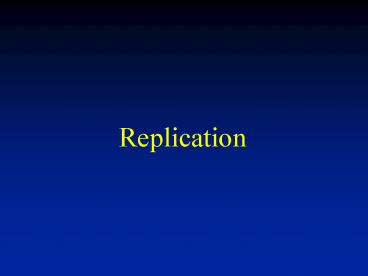Replication - PowerPoint PPT Presentation
1 / 20
Title: Replication
1
Replication
2
Central Dogma of Information Flow
3
Wagging the Dogma
4
Replication
- Replication- the synthesis of DNA using itself as
a template. - Three stages Initiation, Elongation, Termination
5
Replication is Semiconservative
- Meselson-Stahl Experiment
6
Initiation
7
Replication Begins at a Specific Place Each Time
- Origin of replication (ori)
8
Replication is Bidirectional
- Theta structure
9
DNA Must be Uncoiled Before Replication
- Helicase
- ssb
10
Replication is 5 - 3
11
Okazaki Fragments are Used to Synthesize the
Lagging Strand
12
Primers are Needed for Synthesis
- Primase
13
Elongation
- Reaction
14
Termination
- Least well understood
15
Review of Replication - Initiation
- Ori bound by helicase and SSB (other proteins at
site) - Replication bubble forms
- primase and DNA polymerase III join complex
- Okazaki fragments used on lagging strand
- synthesis is 5 to 3
16
Review of Replication - Elongation
- PPi product
- polymerase I removes RNA and fills gap
17
Review of Replication - Termination
- Ligase seals nick (ATP dependent)
- Topoisomerase supercoils DNA (cut, wrap, ligate)
18
Proofreading
- 1 mistake every 105 - 106 bases during
replication (3 - 5 exonuclease activity) - In DNA, 1 mistake every 108 - 109 bases
- other repair mech. must exist
19
Repair Mechanisms
- Mismatch repair
- Base Excision repair
- Nucleotide Excision
- Direct Repair
20
In Eukaryotes, the Major Differences are the
Numbers and Names of the Molecules
- Prokaryotes Eukaryotes
- 1 ori and ter multiple ori and ter
- Polymerases III and I Pols d and a
- Okazaki fragments 1000 100-250 nt
- supercoiling histones































